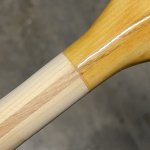I can’t say “I’m done” quite yet, as I’m still doing coats of 85/15 BLO/thinner and the grip especially is still soaking up the oil. But it’s time for the photo shoot!
To sum up the project, this paddle started as a thick-shafted, club-gripped, pizza paddle. It grabbed way too much water for my taste. Since getting my Bruce Smith, I’ve come to appreciate the slender oval shaft, the compact and easy-to-roll grip, and the wonderful handling (it’s gorgeous too). My other paddles are Grey Owl bent shafts, so I’d been looking at the Grey Owl Fleetwood, in part because I love the blade shape. But the grip- meh, didn’t do much for me. The Bruce Smith grip though- attractive and useful. So I traced the blade shape I liked onto the pizza paddle and tried to replicate the Bruce Smith grip; all work within the limits of the radius of my benchtop belt sander.
Here’s a comparison with the original grip as I have 2 more of these Clement Aviron paddles:

And compared to the Bruce Smith I have grown to really love:

The resultant shape is amenable to a thumb hooked around the end of the grip, while the top is contoured much like its inspiration. Making it for me, I just kept rasping and sanding until I liked it.
The blade shape is a slightly stretched tracing of my favorite Grey Owl bent shaft; this was in order to preserve the reinforcing lamination at the tip and avoid carrying the transition from shaft to blade further down the blade. I didn’t need the shaft any longer than it already is; the paddle was 58” overall, and the shaft was already a touch longer than my other paddles.

For all the original paddle’s shortcomings, it was never heavy. But much to my surprise it came in a 1/4 oz lighter than my Bruce Smith!


Here’s a family pic or all three together:

I think I will really enjoy this paddle. I will actually use it which is more than I was doing with it before. Will I modify the 60”? I don’t know. I can see making my own paddles for fun and as I develop further preferences, but I’m not sure about the durability of this softwood paddle yet. I need to make a short push pole (or just remember to take my boring ol plastic and aluminum boat hook) for dealing with extreme shallows or pushing off at the launch etc. as this paddle won’t tolerate much of that sort of abuse. But I don’t subject any of my paddles to such treatment anyway. I’ll keep loading oil on the paddle this week, but I sure hope to get to use it next weekend on our planned float from the Wacissa head down to Goose Pasture.









